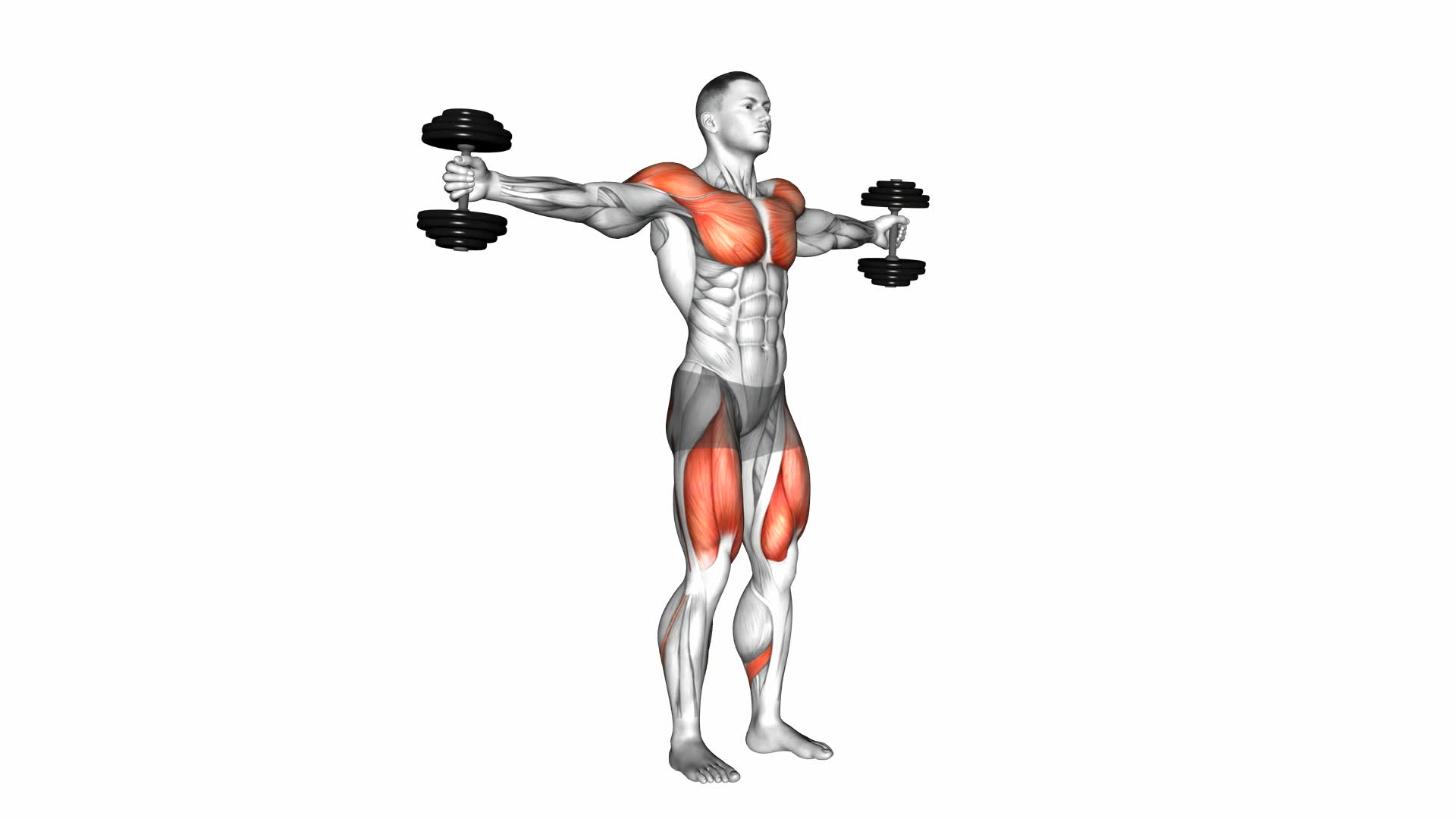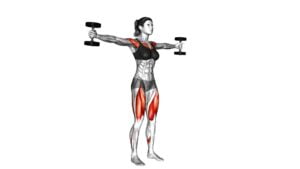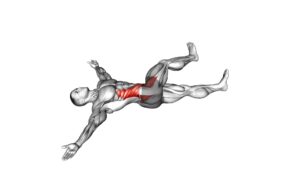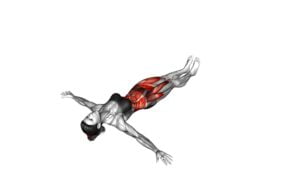Dumbbell Iron Cross – Video Exercise Guide & Tips

Are you looking for an effective full-body exercise that targets multiple muscle groups? Look no further than the Dumbbell Iron Cross.
Watch This Exercise Video
In this video exercise guide, we'll show you the proper form and technique to get the most out of this challenging exercise. Whether you're a beginner or an experienced fitness enthusiast, we've got modifications for all fitness levels.
Avoid common mistakes and maximize your workout results with our expert tips.
Let's get started!
Key Takeaways
- Dumbbell Iron Cross targets multiple muscle groups in the upper body.
- It engages the chest, shoulders, and triceps, building strength and definition in these areas.
- The exercise allows for variations to customize the workout intensity and target specific areas.
- Proper form and technique, as well as avoiding common mistakes, are crucial for injury prevention and maximizing workout results.
Benefits of the Dumbbell Iron Cross
One major benefit of performing the Dumbbell Iron Cross is that it targets multiple muscle groups in your upper body. This exercise engages your chest, shoulders, and triceps, helping to build strength and definition in these areas. By incorporating the Dumbbell Iron Cross into your workout routine, you can effectively work multiple muscle groups simultaneously, saving you time and maximizing your results.
In addition to its muscle-building benefits, the Dumbbell Iron Cross also offers variations that allow you to customize your workout. You can adjust the weight of the dumbbells to increase or decrease the intensity of the exercise, making it suitable for individuals of different fitness levels. Furthermore, you can modify the range of motion by adjusting the angle at which you perform the exercise, targeting specific areas of your upper body. These variations ensure that you can continually challenge your muscles and avoid plateauing in your fitness journey.
Now that you understand the benefits and variations of the Dumbbell Iron Cross, let's move on to the equipment needed for this exercise.
Equipment Needed for the Exercise
To successfully perform the Dumbbell Iron Cross exercise, you'll need some essential exercise equipment. The main equipment required for this exercise is a pair of dumbbells.
However, if you don't have access to dumbbells, you can also use alternative weights such as kettlebells or resistance bands.
Essential Exercise Equipment
You will need dumbbells for the Dumbbell Iron Cross exercise. This exercise is versatile and can be modified to suit different fitness levels and goals. There are several exercise variations you can try, such as performing the iron cross on a stability ball or incorporating a push-up into the movement.
When it comes to choosing dumbbells, it's important to select a brand that's reliable and durable. Some recommended brands include Bowflex, CAP Barbell, and PowerBlock. These brands offer a range of dumbbell weights and designs to cater to different preferences.
Investing in quality dumbbells will ensure that you can perform the Dumbbell Iron Cross exercise safely and effectively.
Alternatives to Dumbbells
If you don't have access to dumbbells, there are other equipment options you can use for the Dumbbell Iron Cross exercise. Resistance bands are a great alternative to dumbbells as they provide a similar resistance and allow for a wide range of motion. You can attach the resistance bands to a sturdy anchor point and hold the handles in each hand to perform the exercise.
Another option is to rely on bodyweight exercises. Instead of using weights, you can focus on performing exercises like push-ups, chest dips, or even handstand push-ups to target your chest and shoulders. These exercises effectively engage your muscles without the need for any equipment.
Remember to maintain proper form and control throughout the movements to maximize the benefits of the exercise.
Proper Form and Technique
To perform the dumbbell iron cross with proper form and technique, there are a few essential tips to keep in mind.
First, make sure to maintain a straight back and engage your core throughout the exercise.
Additionally, avoid using momentum and focus on controlled movements to maximize the effectiveness of the exercise.
Essential Form Tips
How can you ensure proper form and technique while performing the Dumbbell Iron Cross exercise? Paying attention to your form is crucial for maximizing the effectiveness of this exercise and preventing injuries. Here are some essential form tips to keep in mind:
- Maintain a neutral spine: Avoid arching your back or rounding your shoulders. Keep your spine aligned throughout the movement to prevent strain on your lower back.
- Engage your core: Tighten your abdominal muscles to provide stability and support during the exercise. This will help protect your back and improve your overall form.
- Control the weights: Avoid using momentum to swing the dumbbells. Instead, focus on controlled movements, ensuring that you're fully engaging the muscles being targeted.
By following these form tips, you can optimize your performance and reduce the risk of injury.
Now, let's move on to discussing common technique mistakes.
Common Technique Mistakes
To avoid common technique mistakes while performing the Dumbbell Iron Cross exercise, focus on maintaining proper form and technique throughout the movement. This won't only help you improve your form but also prevent any potential injuries.
One common mistake to avoid is using too much weight. It's important to start with a weight that you can handle comfortably and gradually increase it as you become more proficient.
Another mistake is allowing your lower back to arch excessively during the movement. To prevent this, engage your core muscles and keep your back flat against the bench.
Lastly, make sure to fully extend your arms and squeeze your chest muscles at the top of the movement for maximum effectiveness.
Injury Prevention Strategies
Maintain proper form and technique to prevent injuries while performing the Dumbbell Iron Cross exercise. Injury prevention strategies are crucial to ensure your safety and maximize the benefits of this exercise. Here are three key strategies to help you prevent injuries:
- Engage your core: By keeping your core muscles activated throughout the movement, you provide stability and support to your spine, reducing the risk of strain or injury.
- Use appropriate weights: Start with lighter weights and gradually increase as your strength and form improve. Using weights that are too heavy can lead to improper form and increased risk of injury.
- Control the movement: Focus on a slow and controlled movement pattern, avoiding any jerky or sudden movements. This helps to maintain stability and reduces the chance of straining your muscles or joints.
By implementing these injury prevention strategies, you can safely perform the Dumbbell Iron Cross exercise and minimize the risk of injuries.
Transitioning into the next section, let's explore modifications for different fitness levels.
Modifications for Different Fitness Levels
For individuals at varying fitness levels, modifications can be made to the Dumbbell Iron Cross exercise.
If you're a beginner, there are a few modifications you can try to make the exercise more manageable. Firstly, start with lighter weights to build strength and ensure proper form. You can also reduce the range of motion by not fully extending your arms and keeping the dumbbells closer to your body. As you progress, gradually increase the weight and range of motion.
On the other hand, if you're at an advanced fitness level, you can make modifications to challenge yourself even more. Increase the weight of the dumbbells to provide a greater resistance and intensify the exercise. Instead of performing the exercise on a stable surface, you can try doing it on an unstable surface, such as a stability ball or a Bosu ball. This will engage more stabilizer muscles and improve your balance. Additionally, you can add a pause at the bottom of the movement or perform the exercise at a slower tempo to increase time under tension.
Common Mistakes to Avoid
Avoid These Common Mistakes When Performing the Dumbbell Iron Cross Exercise.
To ensure you get the most out of this exercise while minimizing the risk of injury, be sure to avoid the following mistakes:
- Using too much weight: It can be tempting to push yourself with heavy weights, but using too much weight can lead to improper form and potential injuries. Start with a weight that allows you to maintain proper technique throughout the exercise.
- Lifting your head and shoulders off the ground: To effectively engage your core and prevent strain on your neck, keep your head and shoulders on the ground throughout the movement. Lifting them off can put unnecessary pressure on your spine and lead to discomfort or injury.
- Rushing through the exercise: The Dumbbell Iron Cross exercise should be performed with control and precision. Avoid rushing through the movement, as this can compromise your form and reduce the effectiveness of the exercise. Take your time, focus on engaging the correct muscles, and perform each repetition with intention.
By avoiding these common mistakes, you can ensure that you perform the Dumbbell Iron Cross exercise safely and effectively.
Remember to always listen to your body, start with lighter weights if needed, and consult with a fitness professional if you have any concerns or questions.
Tips for Maximizing Your Workout Results
To get the most out of your workout and maximize your results, it's important to focus on proper form and technique throughout the Dumbbell Iron Cross exercise. One key tip for maximizing intensity is to choose the right weight for your fitness level. If the weight is too light, you won't challenge your muscles enough. On the other hand, if the weight is too heavy, you may sacrifice proper form and increase the risk of injury. It's essential to find a weight that allows you to perform the exercise with control and without compromising your form.
Another tip for maximizing your workout results is to vary your workout frequency. While consistency is important, it's also beneficial to give your muscles enough time to recover. This means incorporating rest days into your routine to allow your muscles to repair and grow stronger. Overtraining can lead to fatigue, decreased performance, and increased risk of injury. By finding a balance between challenging your muscles and allowing them to recover, you can optimize your workout results.
Frequently Asked Questions
How Many Sets and Repetitions Should I Do for the Dumbbell Iron Cross Exercise?
To determine the number of sets and repetitions for the dumbbell iron cross exercise, it's important to consider your fitness level and goals. Start with 2-3 sets of 10-12 repetitions, focusing on proper form and control.
As you progress, you can increase the number of sets or repetitions. Beginners can modify the exercise by using lighter weights or performing the movement without weights.
Remember to listen to your body and adjust accordingly.
Can I Perform the Dumbbell Iron Cross Exercise if I Have a Shoulder Injury?
If you have a shoulder injury, it's important to be cautious when performing the dumbbell iron cross exercise. The exercise puts a lot of stress on the shoulders, so modifications may be necessary.
It's recommended to consult with a healthcare professional or a qualified trainer to determine the best modifications for your specific injury.
Alternatively, there are alternative exercises that can target the same muscle groups without putting excessive strain on the shoulders.
Is It Necessary to Warm up Before Doing the Dumbbell Iron Cross Exercise?
Before performing the dumbbell iron cross exercise, it's important for you to warm up. Warming up has many benefits, such as increasing blood flow to your muscles and improving joint mobility. It helps prepare your body for the workout and reduces the risk of injuries.
If you have a shoulder injury and can't perform the dumbbell iron cross, there are alternative exercises that you can do to target the same muscle groups.
How Long Should I Rest Between Sets of the Dumbbell Iron Cross Exercise?
To get the most out of your dumbbell iron cross exercise, it's important to know how long to rest between sets. Rest periods can vary depending on your fitness level and goals. Generally, it's recommended to rest for about 1-2 minutes between sets.
This allows your muscles to recover and ensures you can maintain proper form. Additionally, make sure to choose a weight that challenges you but still allows you to complete the exercise with proper technique.
Can I Incorporate the Dumbbell Iron Cross Exercise Into My Full-Body Workout Routine?
Incorporating the dumbbell iron cross into your full-body workout routine has several benefits for overall strength and muscle development.
This exercise engages multiple muscle groups, including the chest, shoulders, and triceps.
It also improves stability and core strength.
By adding the dumbbell iron cross to your routine, you can enhance your upper body strength and achieve more balanced muscle development.
Make sure to consult with a fitness professional to ensure proper form and technique.
Conclusion
In conclusion, the dumbbell iron cross is a highly effective exercise that targets multiple muscle groups and provides various benefits.
By using proper form and technique, individuals can modify this exercise based on their fitness level and avoid common mistakes.
By following these tips and incorporating the dumbbell iron cross into their workout routine, individuals can maximize their results and achieve their fitness goals.

Author
Years ago, the spark of my life’s passion ignited in my mind the moment I stepped into the local gym for the first time. The inaugural bead of perspiration, the initial endeavor, the very first surge of endorphins, and a sense of pride that washed over me post-workout marked the beginning of my deep-seated interest in strength sports, fitness, and sports nutrition. This very curiosity blossomed rapidly into a profound fascination, propelling me to earn a Master’s degree in Physical Education from the Academy of Physical Education in Krakow, followed by a Sports Manager diploma from the Jagiellonian University. My journey of growth led me to gain more specialized qualifications, such as being a certified personal trainer with a focus on sports dietetics, a lifeguard, and an instructor for wellness and corrective gymnastics. Theoretical knowledge paired seamlessly with practical experience, reinforcing my belief that the transformation of individuals under my guidance was also a reflection of my personal growth. This belief holds true even today. Each day, I strive to push the boundaries and explore new realms. These realms gently elevate me to greater heights. The unique combination of passion for my field and the continuous quest for growth fuels my drive to break new ground.







